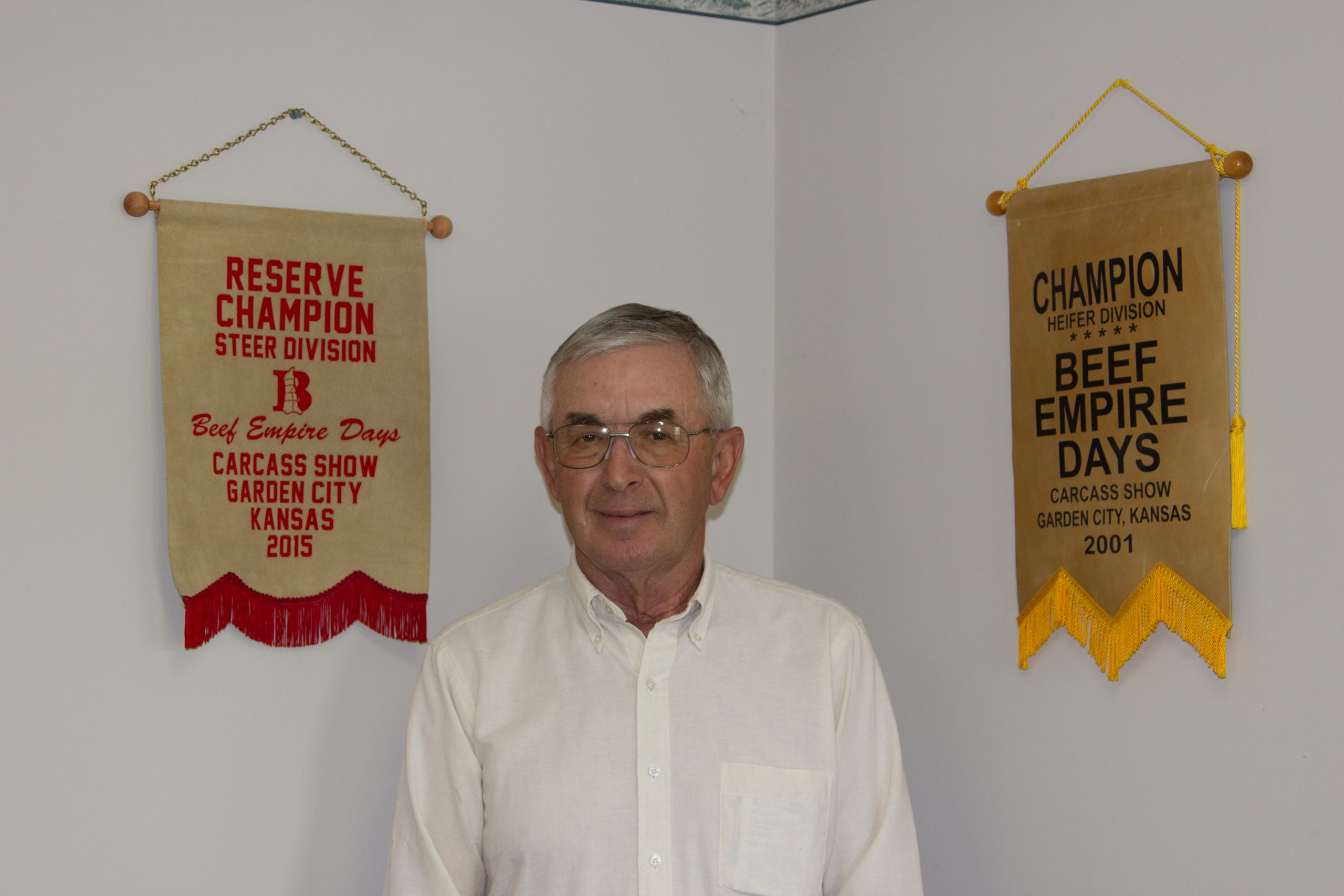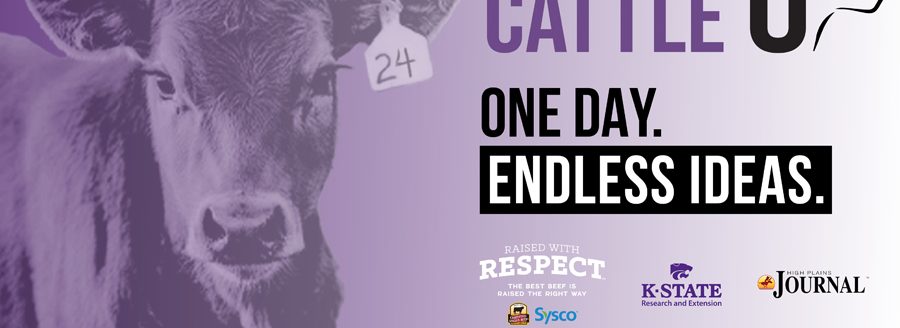Sam Hands has seen many changes in western Kansas farm operations, and his family members are innovators.
The Triangle H operations, south of Garden City, have been incorporating modern practices for many years. Sam is pictured above.
Hands’ great-grandfather, Edwin Ruthin Olomon, came to Garden City 150 years ago when at the age of 16 he left his family to come west and ride the cattle drive. Those Great Plains drives were some of the best known, including from Fort Worth, Texas, to Montana.
The Hands’ family roots of the modern farm operation started around 1900 and, like today, they worked together to make it a success. Sam is the fourth-generation farmer and rancher, and he considers himself fortunate.
“Timing is what it is all about,” he quipped.
In some ways, his operation is similar to an Iowa farmer who feeds out his own cattle. Triangle H has two 4,000-head feedyards —one near the base operation and the other at Deerfield, Kansas.
Today he credits the work of the next generation, which includes his daughter, Marisa Kleysteuber, the manager of the livestock operation; his nephew, Tyler Hands, the farm manager; and employees who keep the operation efficient.
The modern times
He recalls that much of the 1950s “was not a pretty time,” but changes were occurring in western Kansas as a result of the Ogallala Aquifer. Flood irrigation and later sprinkler irrigation spurred the feed grain industry.
At the same time the industry began to see large-scale feedyards, and Hands has watched the growth of the industry. He credits the late Earl Brookover for his vision. The integration of plentiful feed grains and the large packing plants that located in Garden City, Dodge City and Liberal collectively changed the industry.
Today, Nebraska, Kansas, Oklahoma and Texas are the powerhouses in the feeder cattle industry.
Innovation learned and applied
Triangle H has changed, too. In the 1950s, the family was primarily involved in dryland farming with some cow-calf operations. Like other farm operations, Triangle H started with flood irrigation and later on went to sprinkler irrigation application. On the livestock side, Hands went to Kansas State University and learned artificial insemination techniques. He credits the late Calvin Drake, an animal science professor, who encouraged him to continue to build his acumen. That led the Hands family to start having a retained ownership on cattle as Sam returned to the farm after graduation.
He credits two of his brothers, Greg and Cedric, for their vision and work, too.
Sam remembered under his father’s guidance the family began to develop modern irrigation practices. They first rented ground, then began to buy land.
Farming and ranching is always about adapting to efficient practices with an eye on new opportunities, he said.
In the mid-1980s, the operation started to grow more feed and began expanding its feed yards.
Another opportunity
Prices are always at the top of a rancher’s mind. In the late 1980s, Hand remembered, “I was frustrated with the cash markets. Over the years, due to AI, we felt had our most efficient cattle, but I felt we weren’t being rewarded.”
Triangle H started marketing with grid systems as Hands worked with IBP and used a new process that rewarded the operation and guaranteed quality product for the packer.
The decision to “market on the rail” was one of the best decisions the family ever made, he said, because it allows Triangle H to track results and improve the product.
He also works with a select number of cow-calf producers to ensure they can deliver high quality livestock.
Triangle H was among the early investors in U.S. Premium Beef LLC, Kansas City, Missouri, which was formed in 1996.
Hands praised Certified Angus Beef for its work to build market success. Ultimately, consumers define the market. Price, he said, is one factor in success, but quality is a bigger factor.
Water
Hands believes modern crop breeding and genetics have expanded options, but technology and stewardship practices will be paramount to extending the life of the Ogallala Aquifer.
He said sprinkler systems can be modified to better apply moisture, and subsoil water systems will continue to take prominence.
Also, genetics will continue to be important. Sorghum and triticale are proven crops for feeding cattle, so he remains optimistic. Triticale silage, as an example, works well for livestock feed.
“Today we produce more feedstuff with less water due to genetics,” he said.
Water has been intertwined with the High Plains agriculture. Pioneers in the late 19th century tried to develop a ditch irrigation system, including one along the Arkansas River west of Garden City in 1884. While it was not commercially successful, farmers and ranchers worked through semi-arid times. In the 1940s, wells were starting to be a part of southwest Kansas, and that led to flood irrigation in the 1950s.
Now, he said, “We’re using less water, and we’ll have to keep doing that.”
Irrigation brought in corn and alfalfa, which continue to be important.
Hands remains bullish on southwest Kansas agriculture. Genetics will continue to improve corn, he said. Also, wheat and sorghum are proven feedstocks, and he notes the investment that is helping to improve forage sorghum. The growing dairy industry and a number of feedlots will prefer corn silage, and he expects that will continue.
“Sorghum can work well and be cost-effective and efficient,” he said, adding that triticale works well, and the industry can continue to grow and buy in corn from other regions, including northwest Kansas, where dryland corn has become a dependable crop.
Southwest Kansas will continue to import feed from the Corn Belt to support the feedlot industry, he said.
Prepare for challenges
Also, today’s operator has more resources, he said,remembering that his father did not use soil tests or have consultants available to provide data and information. Both resources are important to today’s operator.
He also said the beef cycle will always have challenges. He remembered the cow that killed Christmas in 2003 when a Canadian cow was diagnosed with bovine spongiform encephalopathy, and that rattled a promising market. Other events have included the Great Recession in 2008-09, drought, the Tyson meatpacking plant fire in 2019 and COVID-19. All have dramatically affected markets, but markets do return, and it requires managers to be strategic planners.
“You always have to be prepared and do what’s best with the resources you have been blessed with,” Hands said.
His own philosophy is to be as efficient as he can with resources and to remember “Change is not necessary because success is not mandatory.”
Dave Bergmeier can be reached at 620-227-1822 or [email protected].




